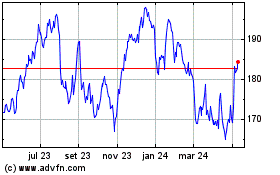Facebook, Google, Apple Hit by Outages -- 3rd Update
14 Março 2019 - 9:21PM
Dow Jones News
By Georgia Wells and Robert McMillan
Computer systems at three of the world's largest technology
companies went offline temporarily this week, thanks to an unusual
and apparently coincidental series of glitches at Facebook Inc.,
Google and Apple Inc.
Facebook grappled with the most significant issues, blaming one
of its longest-ever outages on a server-configuration error. The
daylong outage that began Wednesday disrupted access to its core
app, its photo-sharing app Instagram and its messaging service
WhatsApp.
"Yesterday, as a result of a server configuration change, many
people had trouble accessing our apps and services," Facebook said
in a tweet Thursday. "We've now resolved the issues and our systems
are recovering. We're very sorry for the inconvenience and
appreciate everyone's patience."
A Facebook status page for developers had listed the outage as
lasting 24 hours as of noon on the East Coast. An overnight message
on Instagram's Twitter account had said the photo-sharing service
was back running again, though some users reported lingering
issues.
At Alphabet Inc.'s Google, some services, including Gmail, were
slowed or outright inaccessible from Tuesday evening into early
Wednesday on the East Coast. Google blamed a "cascading failure"
that began after its engineers made tweaks to an internal storage
service.
Separately, several of Apple's iCloud services were upended for
more than four hours Thursday, according to the company's
systems-status website.
While internet companies occasionally experience outages caused
by problems ranging from natural disasters to surges of web
traffic, it is rare for so many established companies to go down in
one week and, in Facebook's case, to be disrupted for so long. The
glitches knocked out a range of services -- email, messaging,
social sharing, photos -- relied on by people around the globe.
"They're three really good, strong, technically innovative
companies," said Christopher Brown, chief technical officer with
Uptime Institute LLC, a company that provides consulting services
on data-center reliability. "For them to have issues like this, it
just goes to show how complex these systems are."
Facebook's disruption was significant not just in its length but
its scope. The company has more than 1.5 billion daily users spread
across its family of apps.
That size alone could be the culprit, said Jonathan Heiliger, a
tech investor at Vertex Ventures who formerly was head of
infrastructure at Facebook. As the company has moved to automate
aspects of its tech, problems become more difficult to squash.
"Restarting the site: That is a big and complicated exercise
that takes a lot more time than fixing the problem," Mr. Heiliger
said.
The outage came as Facebook dealt with a different sort of
disruption: the abrupt departure of a senior executive viewed as a
potential successor to Chief Executive Mark Zuckerberg.
Facebook communicated little about the outage, except to say it
wasn't related to a distributed denial-of-service attack, in which
nefarious actors coordinate to bring down a service. Facebook
hasn't publicly identified the cause of the outage. Its primary
communications about the outage had taken place on Twitter.
The outage could force Facebook to issue refunds to advertisers
-- many of which use its platforms as a core means of reaching
consumers -- and further damage a brand already dented by scandals
surrounding privacy and data protection. Even a one-day refund
could sting: In its most recent quarter, Facebook logged $16.92
billion in revenue, or about $188 million a day.
At least one company benefited from Facebook's blip. Telegram
Chief Executive Pavel Durov said in a public post that three
million people signed up for the messaging company within 24
hours.
Rob Copeland contributed to this article.
Write to Georgia Wells at Georgia.Wells@wsj.com and Robert
McMillan at Robert.Mcmillan@wsj.com
(END) Dow Jones Newswires
March 14, 2019 20:06 ET (00:06 GMT)
Copyright (c) 2019 Dow Jones & Company, Inc.
Apple (NASDAQ:AAPL)
Gráfico Histórico do Ativo
De Mar 2024 até Abr 2024

Apple (NASDAQ:AAPL)
Gráfico Histórico do Ativo
De Abr 2023 até Abr 2024
